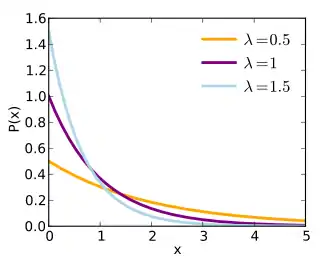Exponential Distribution
Probability density function | |
Cumulative distribution function | |
| Parameters | λ > 0 rate, or inverse scale |
|---|---|
| Support | x ∈ [0, ∞) |
| λ e−λx | |
| CDF | 1 − e−λx |
| Mean | λ−1 |
| Median | λ−1 ln 2 |
| Mode | 0 |
| Variance | λ−2 |
| Skewness | 2 |
| Ex. kurtosis | 6 |
| Entropy | 1 − ln(λ) |
| MGF | |
| CF | |
Exponential distribution refers to a statistical distribution used to model the time between independent events that happen at a constant average rate λ. Some examples of this distribution are:
- The distance between one car passing by after the previous one.
- The rate at which radioactive particles decay.
For the stochastic variable X, probability distribution function of it is:
and the cumulative distribution function is:
Exponential distribution is denoted as , where m is the average number of events within a given time period. So if m=3 per minute, i.e. there are three events per minute, then λ=1/3, i.e. one event is expected on average to take place every 20 seconds.
Mean
We derive the mean as follows.
We will use integration by parts with u=−x and v=e−λx. We see that du=-1 and dv=−λe−λx.
Variance
We use the following formula for the variance.
We'll use integration by parts with and . From this we have and .
We see that the integral is just which we solved for above.